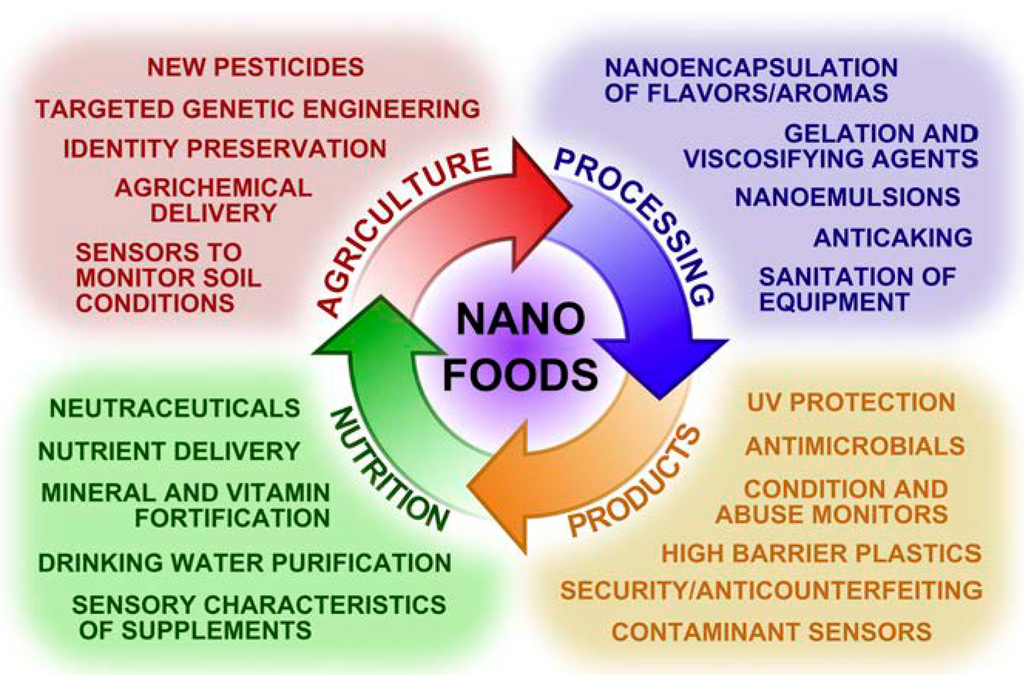What surprises me most about nanotechnology is how it is
already incorporated into so many products that I use on a regular basis such
as sunscreen, cosmetics, and food and I had little previous knowledge of its
existence. It was especially startling to hear about such shady products like
the Chocolate Slim Shakes that are nanoparticles coated in chocolate. Dr.
Gimzewski discussed in his lecture that more research is needed to understand
the true long-term risks or benefits of using nanotechnology in these kinds of
products. Could I be unknowingly harming my health by using these products?
Summary of uses of Nanotechnology in food
Though there is still some uncertainty
surrounding it, nanotechnology has also opened up a new artistic world to
explore on the nano-scale. For example, in 2004 Ghim Wei Ho, a PhD student in
nanotechnology at the University of Cambridge, made nanoflowers using
nanotechnology. These images of nanoflowers taken with a scanning electron
microscope are both beautiful and have great scientific potential to be used in
new types of solar cells or water repellant coatings.
Nanoflower Bouquet by Ghim Wei Ho
Nano Sunflower by Ghim Wei Ho
While Ghim Wei Ho’s work appears
to be a positive product of nanotechnology, other artists have recognized the
potential for destructive results of nanotechnology. Artist Darcy Lewis created
Nebula of Man in hopes to inspire
others to stay away from nanotechnology’s potential to be used in weapons and
other negative uses and to stay focused on its beneficial uses such as in
medicine. The image was made using layers of nano images and others to show the
effects of nanotechnology to our larger world and universe.
Nebula of Man:
Computer manipulation by Darcy Lewis
Nanotechnology has a lot of
potential to either positively or negatively impact the world. Hopefully the
products that are already in use today and those in the future will be like
Ghim Wei Ho’s nanoflowers rather than the questionable Chocolate Slim Shakes.
References
Darcy, Lewis. Nebula of Man. Digital image. The New York Times. N.p., 17 Jan. 2008. Web. 24 May 2015. <http://graphics8.nytimes.com/images/2008/01/17/technology/17DarcyLewis_Nebula.jpg>.
Duncan. Applications of Nanotechnology in Food Packaging and Food Safety: Barrier Materials, Antimicrobials and Sensors. Digital image. MDPI. N.p., 22 Aug. 2014. Web. 24 May 2015. <http://www.mdpi.com/polymers/polymers-06-02247/article_deploy/html/images/polymers-06-02247-g008-1024.png>.
"Fantastic Nano-Voyage." Astrobiology Magazine. N.p., 24 June 2004. Web. 24 May 2015. <http://www.astrobio.net/topic/exploration/robotics-a-i/fantastic-voyage/>.
Ho, Ghim Wei. Nano Sunflower. Digital image. Nanotechnology Now. N.p., 2004. Web. 24 May 2015. <http://www.nanotech-now.com/images/Art_Gallery/GWH-sunflower-sm.jpg>.
Ho, Ghim Wei. Nanoflower Bouquet. Digital image. Nanotechnology Now. N.p., 2004. Web. 24 May 2015. <http://www.nanotech-now.com/images/Art_Gallery/GWH-bouquet-sm.jpg>.
Introduction to Nanotechnology for Artists, Part 6. By James K. Gimzewski. Youtube. N.p., 21 May 2012. Web. 24 May 2015. <https://www.youtube.com/watch?list=PL9DBF43664EAC8BC7&v=oKlViSKkPd0>.
Lang, Tim, and Frans Kampers. "Nanotechnology in Food: More than a Question of Taste." The Guardian. N.p., 26 Apr. 2013. Web. 24 May 2015. <http%3A%2F%2Fwww.theguardian.com%2Fwhat-is-nano%2Fnanotechnology-food-more-than-question-taste>.
Lewis, Darcy. "Is NanoArt the New Photography?" The New York Times. N.p., 17 Jan. 2008. Web. 24 May 2015. <http%3A%2F%2Fwww.nytimes.com%2Fslideshow%2F2008%2F01%2F17%2Ftechnology%2F20080117_NANOART_SLIDESHOW_3.html>.
Ortiz, Christina. "Wait, There's Nanotech in My Food?" Popular Mechanics. N.p., 19 Feb. 2014. Web. 24 May 2015. <http://www.popularmechanics.com/science/health/a12790/wait-theres-nanotechnology-in-my-food-16510737/>.
Piquepaille, Roland. "Would You Like a Bouquet of Nanoflowers?" Roland PiquePailla's Technology Trends. N.p., June 2004. Web. 24 May 2015. <http://radio-weblogs.com/0105910/2004/06/22.html>.




Hi Stephanie,
ReplyDeleteI think you are completely right in your hesitation towards the widespread application of nanotechnology. It is scary to think that nanotechnology is used in food and sunscreen and other day-to-day products without sufficient research done on them. Dr. Gimzewski himself warns that we must do more research to see what the negative side effects of things like silicon nanoparticles and their ingestion are. At the same time, however, it is amazing to see the doors that nanotechnology opens. The fact that zinc oxide, for example, can be manipulated on a molecular level to become transparent as opposed to opaque, while still maintaining its sunscreen-like protection. Your juxtaposition of Darcy Lewis and Ghim Wei Ho is also very interesting, because it shows a fundamental truth: the advantages and perilous disadvantages of nanotechnology and its widespread use must be equally analyzed and taken to heart as we move forward in this emerging age of nanotechnology.